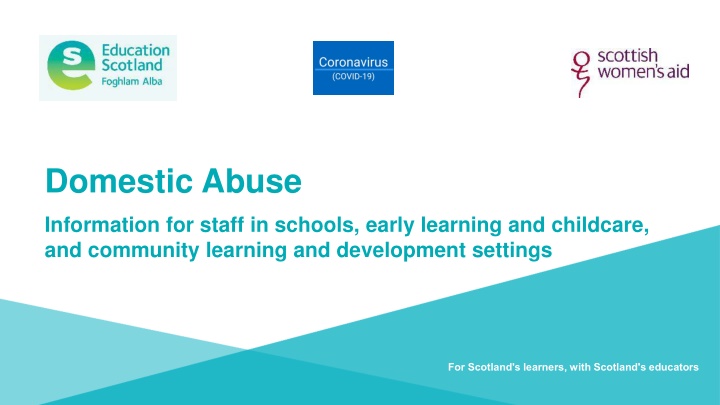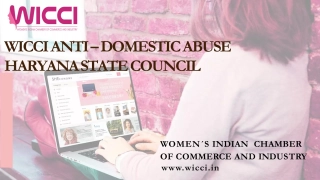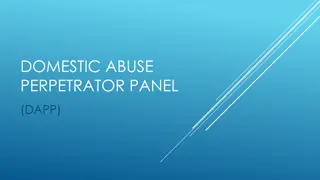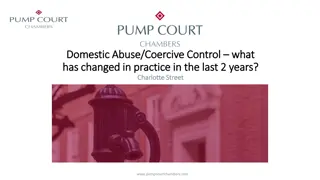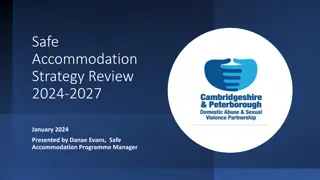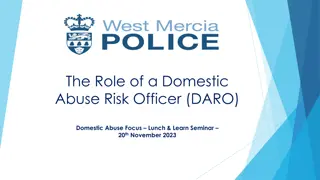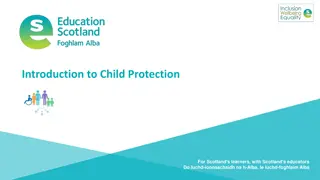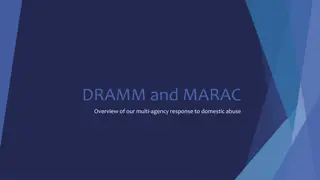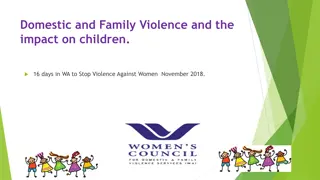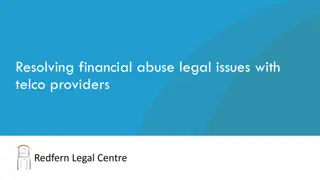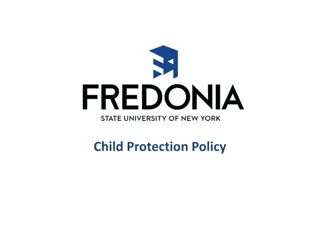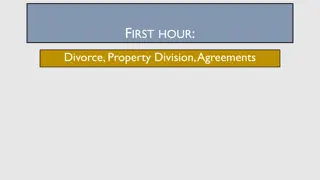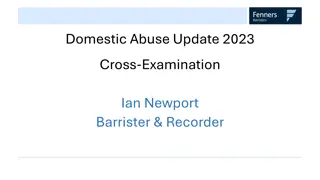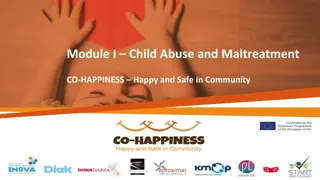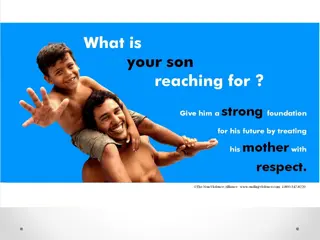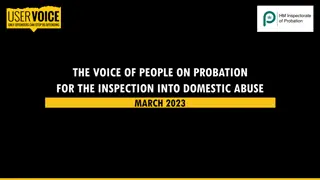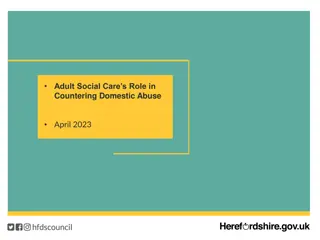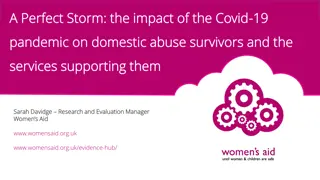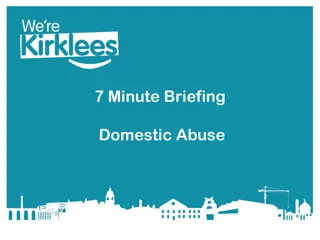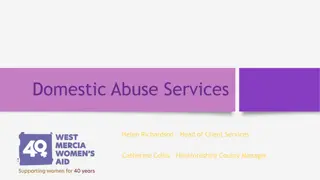Domestic Abuse and Supporting Children in Scotland
This presentation provides information on domestic abuse, its impact on children and young people, signs of abuse, and the role of adults in supporting learners in educational settings in Scotland. It highlights the prevalence of domestic abuse, defines what domestic abuse is, explores how children and young people can be affected, and discusses the violation of children's rights. The presentation emphasizes that the impact of domestic abuse on children and young people can be mitigated with the support of caring adults.
Download Presentation

Please find below an Image/Link to download the presentation.
The content on the website is provided AS IS for your information and personal use only. It may not be sold, licensed, or shared on other websites without obtaining consent from the author.If you encounter any issues during the download, it is possible that the publisher has removed the file from their server.
You are allowed to download the files provided on this website for personal or commercial use, subject to the condition that they are used lawfully. All files are the property of their respective owners.
The content on the website is provided AS IS for your information and personal use only. It may not be sold, licensed, or shared on other websites without obtaining consent from the author.
E N D
Presentation Transcript
Domestic Abuse Information for staff in schools, early learning and childcare, and community learning and development settings For Scotland's learners, with Scotland's educators Transforming lives through learning Document title
Welcome This presentation aims to support your professional learning. After participating in this learning activity you will have an awareness of: The nature of domestic abuse The impact on children and young people Signs of abuse The role of adults in supporting learners You will have an opportunity to explore and reflect on the implications for your setting. The National Model of Professional Learning For Scotland's learners, with Scotland's educators Document title
Domestic Abuse Statistically at least one child in every class will have experience of domestic abuse. One in 5 children in the UK will have experienced domestic abuse by the time they reach 18. For Scotland's learners, with Scotland's educators Document title
What is domestic abuse? Domestic abuse is a pattern of behaviour that instils fear and is used by abusers to maintain control. It includes any pattern of controlling, bullying, threatening or violent behaviour towards a partner or ex-partner including psychological and emotional abuse (coercive control). For Scotland's learners, with Scotland's educators Document title
Children and young people and domestic abuse Children and young people can experience domestic abuse: directly from the abuser indirectly via the abuse of their non-abusing parent young people can experience domestic abuse in their own intimate relationships For Scotland's learners, with Scotland's educators Document title
The experience of domestic abuse for children and young people Violation of children s rights For Scotland's learners, with Scotland's educators Document title
The impact of domestic abuse for children and young people Impact is not inevitable: supportive adults can make a difference Mental Wellbeing Increased internalising and externalising difficulties Post traumatic stress Difficulty regulating emotions High separation distress Feelings Fear, Powerlessness, Depression or sadness Anger and guilt Anxiety Negative impact on social relationships, educational achievement and family relationships Document title Physical health links to obesity, asthma and bodily complaints For Scotland's learners, with Scotland's educators
Activity: Signs of domestic abuse For Scotland's learners, with Scotland's educators Document title
Domestic abuse in teenage relationships 6% of reported cases of domestic abuse involved young people under 18 (Scotland 2018-19) The last major survey of abuse in young people s relationships (2009) found: 75% of girls and 50% of boys experienced emotional abuse of some form 25% of girls and 18% of boys experienced physical abuse 33% of girls and 16% of boys experienced sexual abuse One in 6 girls reported severe abuse. Abuse in teenage relationships can include the factors already outlined for adults and may also include sexting, requesting or sharing of images, sharing of pornography, sexual coercion and grooming. These behaviours can be considered normal in peer groups. For Scotland's learners, with Scotland's educators Document title
It is vital that young people have the opportunity to have a safe space to discuss their experiences to help them identify healthy and unhealthy relationships. This is a film by young people for young people about abuse in relationships. For Scotland's learners, with Scotland's educators Document title
Activity: Responding to disclosures of domestic abuse Activity In pairs, discuss what you would do if a child or young person disclosed domestic abuse. Consider What might you say to the child or young person? What you would do next? Read the suggestions on P. 9. What are your child protection guidelines in this situation? What should you do if you have concerns but no one has made a disclosure? For Scotland's learners, with Scotland's educators Document title
What can help? A curriculum and culture that promotes positive relationships and respect Many abused children will not be identified so a nurturing, trauma informed response is crucial for all learners Staff who are trained and aware (including non-teaching staff) Clear safeguarding policies and guidance Strong partnerships with local specialist domestic abuse services-for support for children and families and for professional development Including the views of children and young people who have experienced abuse Awareness raising for learners on keeping safe and seeking help if they don t feel safe For Scotland's learners, with Scotland's educators Document title
A whole school approach to ending gender-based violence Whole school approach to ending gender- based violence For Scotland's learners, with Scotland's educators Document title
Domestic abuse and additional support needs There are a wide range of factors which may lead to some children and young people having a need for additional support. These fall broadly into the four overlapping themes highlighted in the graphic. Activity Consider what you have learned to date about domestic abuse. What additional support needs might arise? For Scotland's learners, with Scotland's educators Document title
Activity : Responding effectively to domestic abuse This activity can be done individually or with colleagues make a note of your reflections Focus How effective is our response to domestic abuse? Reflection In my class In our learning community In our local authority What I /we do well What needs to improve How to improve For Scotland's learners, with Scotland's educators Document title
Scotlands Domestic abuse and Forced Marriage 24 hour helpline 0800 027 1234 For Scotland's learners, with Scotland's educators For Scotland's learners, with Scotland's educators Document title
